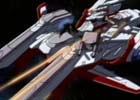Mobile Suit Gundam SEED
| Japanese Title: Kidou Senshi Gundam SEED | ||
| Also Known As: Gundam SEED, SEED | ||
| Genre: Action/Drama | ||
| Format: 50 Episodes | ||
| Allegiance: Sunrise | ||
| Director: Fukuda Mitsuo | ||
| Vintage: 2002-2003 | ||
| Intelligence Agency Report by: Djudge | ||
| With the nuclear catastrophe that occurred during the ‘Bloody Valentine’ incident, war has been sparked between the Naturals of the Earth Alliance and the Coordinators of ZAFT. Now, nearly a year later on the neutral space colony of Heliopolis, the Naturals are ready to strike back against ZAFT’s mobile suit onslaught by preparing to activate both the top-secret experimental Gundams and battleship in their possession. However, before the Alliance can use these new weapons, ZAFT launches a daring surprise attack to capture the prototypes. Under desperate circumstances, Kira Yamato, a resident of the colony, finds himself whisked into the cockpit of the last remaining Gundam, Strike. Can he summon enough courage and skill to save his friends… even the one shooting at him? | ||
|
|
||
| Field Agent Report by: Djudge | ||
| Plot Characters Impact Visual Audio |
7.25 7.75 7.00 8.50 9.00 |
|
| Overall | 7.25 | |
| (not an average) | ||
Gundam SEED easily stands as one of the most popular titles of last year, if not the whole decade. Backed by flashy mecha designs and a wide assortment of excellent J-Pop in its soundtrack, SEED comes off as the prettiest title of the franchise. Unfortunately for director Fukuda Mitsuo, SEED stands as nothing more than just that. Recycled plot material along with repeated sequences kill off any hope of the series being fine-tuned. Couple those last vices with an ultra-condensed conclusion and it is easy to see why this show got so much flak from some of the general audience.
First off, SEED showcases some of the sharper Gundam designs ever seen in the franchise. A rich palette of colors complemented the sleek mobile suits in this series. The end result: a disturbingly colorful, sharp, and detailed series of one-on-one Gundam/ship duels that would put a number of contemporary action titles to shame. As for the actual characters themselves, the design work that went into them is noticeably on a notch lower than their mechanized counterparts. They all seemed unique enough one way or another, but they were fairly neutral in overall visual appeal and seemed to have their initial allure blur away as the series wore on. Animation, on the other hand, started off as being above average with some well-integrated CGI work, but quickly degenerated once the tempo began to pick up. The most annoying aspect ofSEED is easily the deplorable sin of constantly using old animation sequences to full in successive battle scenes. I definitely do not remember doing anything more frequently than scoffing at watching the same turrets fire and mobile suit explode time and time again. A shame that Sunrise didn’t put in more resources that they probably acquired as a result of the show’s explosive success into creating fresh strings of animation for their viewers. On a final note, SEED like several other entries into the Gundam franchise, sports some incredible tunes. Keep your ears open for some great themes from some of J-Pop’s biggest acts, such as T.M. Revolution.
As for the plot, hardcore Gundam fans will easily spot the crystal clear Universal Century timeline elements that were infused into SEED’s universe. The Naturals and Coordinators of this title are dead-ringers for the Oldtypes and Newtypes from the original Mobile Suit Gundam. The ominous figure of Raw Le Klueze? He’s nothing more than a Zechs Marquise/Char Aznable/Zabine Chareaux/Schwartz Bruder cutout complete with his own ‘unique’ mad agenda. As you can see, this is just a little of the ‘borrowed’ material that SEED uses in conjunction with some fairly predictable stock plot material. If you ever wanted to have your Gundam title pumped up in the story department, you may have come to the wrong place as even those last scuffs in the show’s polish aren’t the last straw. Ending the title’s fifty-episode run is one of the more condensed endings that I have ever seen put to an anime. Many of the show’s characters resolve their conflicts and realize their destinies in these final installments, but the cast as a whole do so in rushed and disorganized manner leaving the viewer befuddled. Combine that with the bland anti-war messages that are used to cease hostilities in the final arc and you have a cacophony of jumbled themes and foci that end up backfiring and only partially come clearly received to the ears and minds of the viewer. There was simply too much material to process and not enough time to do so. A shame, since althoughSEED is regarded as bland by most of the older, more established Gundam community, the title really caught my attention in the time that I spent viewing it.
In sum, the bottom line is that this particular Gundam title fell short of the hype that was attributed to it, a practice common amongst shows of SEED’s popularity. However, Gundam SEED is not a totally unworthy successor to Tomino’s legendary brainchild. In some ways, it paves the way, a vibrant one at that, for yet another wave of otaku to become exposed to the Gundam franchise or even the medium of anime in general. As for all you other Gundam nuts out there, be warned that SEED is probably amounts to nothing than just fifty episodes of previously viewed material.




